|
Spyker have
become the latest Formula 1 team to use Ferrari customer
engines, and their first car to be powered by the
Maranello-built 2.4 V8 units, the F8-VII, was launched at
the Silverstone circuit in the UK yesterday. Team principal Colin Kolles
presented the team’s latest challenger as well as the drivers Christijan Albers and Adrian Sutil and an exciting
new test driver line-up, at the Northamptonshire circuit.
Managing
director and team principal Colin Kolles predicted a
‘transition year’ for the team, with a focus in the early
part of the year on improved reliability and performance,
before a big step forward with a revised B-spec car towards
the second part of the year. “We know that the first half of
the season could be challenging for the team, but with the
stability that Spyker has brought with it, we’ve got a real
direction and focus now,” Kolles explained. “We know that
Spyker want to make the project work, and we’ve already set
about making changes to turn the team around. One of the
first steps was to bring in Mike Gascoyne to lead the
technical team and help give the direction we need.”
Chief technical
officer, Mike Gascoyne, added, “Since I arrived at Spyker
three months ago, I’ve been looking carefully at the
technical department to put in place the personnel,
procedures and resources that will give the team structure;
already we’ve doubled our aerodynamic resources with a
second wind tunnel and dedicated team in Italy. As a team
we’re looking at planning for the future through a more
structured approach by prioritising key aspects that will
give a big improvement rather than small, gradual steps. I’m
looking forward to seeing the results of the changes in the
second half of the season when we deliver an improved B-spec
package.”
Twenty-seven
year old Dutch driver, Christijan Albers, remains with the
team for a further year. Albers, although not satisfied with
the results of the 2006 season, showed speed and
determination throughout. Albers commented, “As a driver I
always drive to the maximum, but in 2006 I could not when
always show the best I could do. I’ve worked closely with
the team over the winter to help highlight the areas we need
to improve and I’m pretty confident that in the second half
of the year we’ll start to see the improvements. Having Mike
on board and additional resources shows everyone we’re
serious about progressing. There’s already been some
exciting developments and we’ll start seeing even more over
the second half of the year.”
Albers will be
joined by Adrian Sutil in the driver line-up. Sutil competed
in the F3 EuroSeries alongside McLaren’s British driver
Lewis Hamilton in 2002 and won the 2003 Japanese Formula 3
title. The 24-year-old German completed Friday testing
duties with the team in 2006 and looks forward to his first
Grand Prix start in Australia, “It’s a great feeling. For
sure it’s very nice to be a real part of the team as a race
driver. My aim is to work with the team and progress with
them to the next level. I want to help develop the car more
and help to go forward. I also want to learn the circuits
and get to know the F1 business as much as I can. It’s not
just the driving, it’s the pressure and the press too, but
it’s all a new experience so I’ll take everything step by
step. First, I really want to get going and get some real
mileage under my belt.”
The team also
presented its test and reserve driver line-up for the 2007
season. Fairuz Fauzy, 24 from Kuala Lumpur, Malaysia,
competed in GP2 last season and is supported by a host of
Malaysian companies. He will complete Friday duties at a
selection of this year’s Grands Prix. Giedo van der Garde,
from Rhenen, Netherlands is graduating as an F3 Euroseries
race winner to be a test and Friday driver, while Adrian
Valles from Alicante, Spain, runner-up in the 2005 World
Series by Renault championship and GP2 contender, and Markus
Winkelhock will be the test and development drivers for the
season. Winkelhock remains with Spyker for a further season
after impressing in the 2006 Friday sessions. The team’s
preparations for the season continue today with an
exclusive two-day shakedown at Silverstone. The 17-race
season will get underway in Melbourne, Australia, from 16 –
18 March 2007.
The Spyker
F8-VII’s designation is directly related to Spyker’s rich
heritage as a motor car and aircraft manufacturer.
|
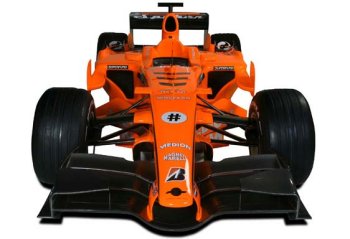
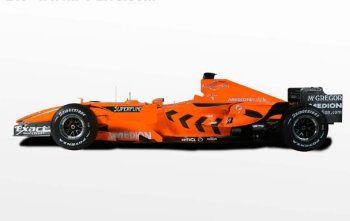
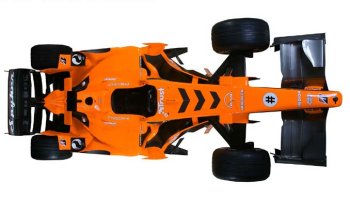
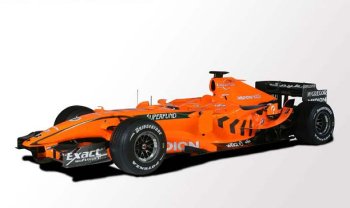 |
|
Team principal Colin Kolles
presented the team’s latest challenger as well as the drivers Christijan Albers and Adrian Sutil and an exciting
new test driver line-up, at the Northamptonshire circuit. |
|
|
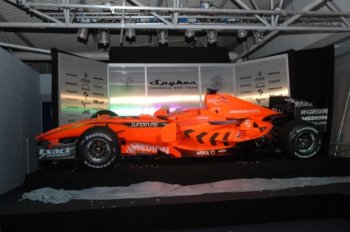
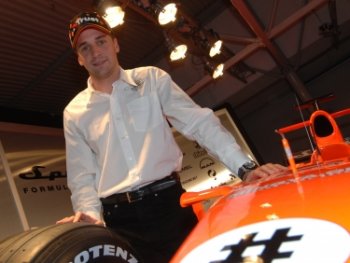

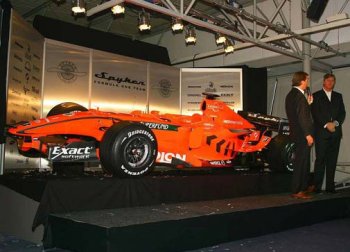 |
|
Spyker have become the latest Formula 1 team to use
Ferrari customer engines, and their first car to be
powered by the Maranello-built 2.4 V8 units, the
F8-VII, was launched at
the Silverstone circuit in the UK yesterday. |
|
|
When the company started trading at the beginning of the
20th century it launched the car models named A, B and C to
the market. When Spyker CEO Victor Muller resurrected the
Spyker name in 2000 he wanted to build on that strong
history, “When we launched the first modern line of Spykers,
the C8 Spyder, we called it the C line to follow on from the
original model rationale. The E line will be launched in the
near future, so it makes sense for our Formula 1 car, our
latest model, to be the F line.”
The number eight
refers to the number of cylinders of Spyker’s Ferrari
engine, as with the road going Spykers such as the C8
Spyder, which has an eight cylinder engine as well. The VII
sub-designation (‘7’) refers to Spyker’s heritage as an
aircraft manufacturer where all models were denoted by roman
numerals and stood for the year the aircraft was launched.
Hence the F8-VII is the Spyker F line with eight cylinders
in 2007.
Spyker’s aim
with the new F8-VII was to create a solid base on which to
build, with the real focus is on upgrading the car through
the course of the season and preparing for the future. Key explains:
‘We set out with a plan to improve on the areas that we knew
needed improving on the M16. We also tried to second guess
as best we could what the 2007 tyres were going to do, and
we worked hard on aero, which is of course always the
fundamental thing. That way we could concentrate all our
efforts on performance related areas.
‘On the
mechanical side, where a system worked well – like the
steering rack for example – we more or less left it alone.
We’ve maintained a very high chassis, because we felt that
offered a lot of volume for aero devices in that area. We
had a twin keel before, and we wanted to tidy it up and make
it neater and stiffer. There are little ‘bumps’ there now,
so it’s effectively zero keel compared to what we had
before. We followed the
same philosophy that we had with the M16, which was to try
to keep as much volume forward as possible. That allows us
to make the back as tight as we can. We have slightly
lengthened the gearbox, and tried to make sure that our
exhaust and radiator volume is pushed forwards, so we’ve got
of bit of scope at the back of the car to do what we like.
We’ve also made a concerted effort to tidy up the outside of
the gearbox as well.’
Inevitably, the
change of engine supplier was also a focus of attention,
‘The Ferrari engine installation was very different to that
of its predecessor, so some of the guys who were
concentrating on certain new areas had to start working on
installing the engine. For example, the hydraulics are our
responsibility once more, whereas previously Toyota looked
after the system, and it came as part of the engine. The back of the
chassis is very different, the gearbox design is very
different, the fuel system has different requirements. It’s
not that it’s a complicated engine installation; it’s just
for us a very different configuration compared to our
previous two engine suppliers.’
While James and
his team have focussed on ensuring the F8-VII is a solid car
to start the season with, chief technical officer, Mike
Gascoyne, has focussed on putting in place measures that
will drastically improve performance later in the year.
“We’ve started to look at areas that will give a good step
forward rather than small ones. With Aerolab on board and a
restructure, we can make some real progress. I think you’ll
see quite a large update to the rear suspension, and a lot
of other things will change. The programme we have in the
first half of the year is really geared towards making big
progress in terms of aerodynamics and design.”
|
|
|
|